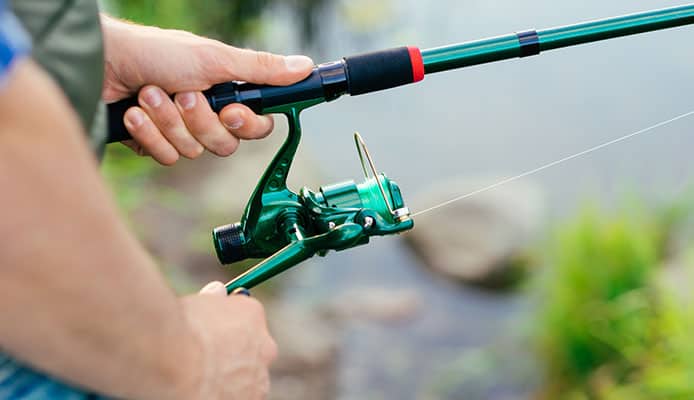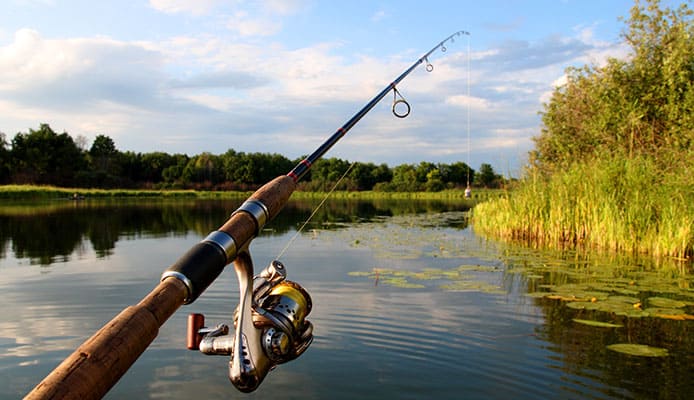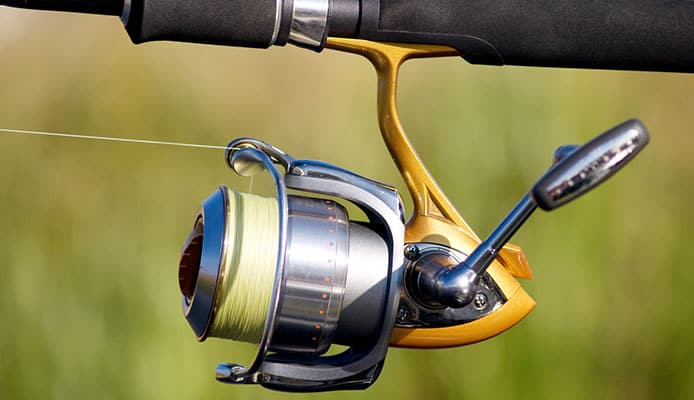
-
1.
-
2.
-
3.
-
4.
-
5.
Whether you are an experienced fisher or new to the sport you likely understand the key to a great experience is having quality gear. Spinning reels are a huge part of this and can mean the difference between getting the catch and being left empty handed. Replacing and upgrading your reel can completely enhance your experience on the water. As more and more people are taking to this sport, there are many different companies in the race to make the best reel. For a fisherman, this means that the quality has gone up and the cost, way down.
Purchasing your next fishing reel can be a confusing task. With lots of specific terminology and options specifically for freshwater or saltwater and even fish dependent, finding a spinning reel can be a challenge. We are here to help you navigate through these murky waters, pun intended, to help you find the best gear for your fishing experience – and your bank account.
The 10 spinning reels listed below are amongst the many available on the market. These specific ones have been researched to be the perfect balance between quality and cost making them the best value purchases. With the help of this guide, you should be able to find the best fishing spinning reel to help make your time on the water even more enjoyable.
Ready to get started? Let’s go.
OUR TOP PICK
Penn Battle II Spinning Reel
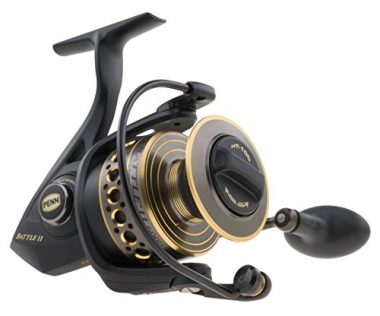
- What Makes This Spin Reel Stand Out
- 1 year warranty
- Carbon fiber
- Many options to choose from
Max Drag: 15 pounds
Gear Ratio: 6.2:1
Weight: 10 ounces
Mono Line Capacity: 270/8; 220/10; 165/12
Ball Bearings: 6+1
EDITORS CHOICE
Daiwa BG Big Fish Spinning Reel
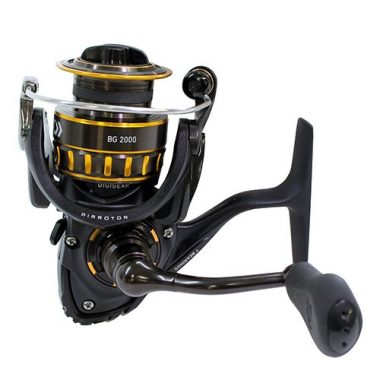
- What Makes This Spin Reel Stand Out
- Lightweight
- Many added features
- Strong and durable materials
Max Drag: 4.4 – 33 pounds
Gear Ratio: 6:1
Weight: 8.1 ounces
Mono Line Capacity: 4/155, 6/100, 8/80
Ball Bearings: 6+1
BEST VALUE
KastKing Summer And Centron Spinning Reel
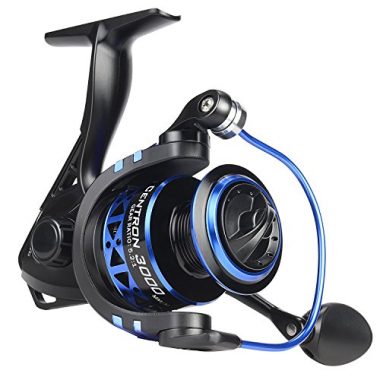
- What Makes This Spin Reel Stand Out
- One year warranty
- Exceptional value
- Right and left handed performance
Max Drag: 12 pounds
Gear Ratio: 5:2:1
Weight: 9 ounces
Mono Line Capacity: 0.35/160
Ball Bearings: 9
Shimano Stradic HG Freshwater Fishing Spinning Reel
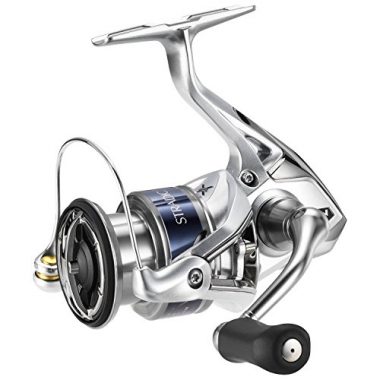
- What Makes This Spin Reel Stand Out
- Cold forged technology
- Hagane body
- Counterbalanced
Max Drag: 7 – 24 pounds
Gear Ratio: 6:1
Weight: 8.3 ounces
Mono Line Capacity: 6/200, 8/140, 10/120
Ball Bearings: 6+1
Sougayilang Ultralight Spinning Reel
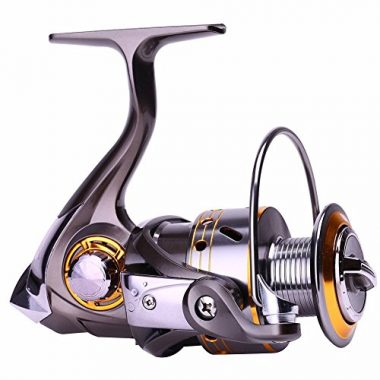
- What Makes This Spin Reel Stand Out
- 13 ball bearings
- Ultra smooth operation
- Highly durable materials
Max Drag: 13 pounds
Gear Ratio: 5.2:1
Weight: 10.6 ounces
Mono Line Capacity: 8/140
Ball Bearings: 12+1
Okuma Avenger ABF Graphite Bait Feeder Spinning Reel
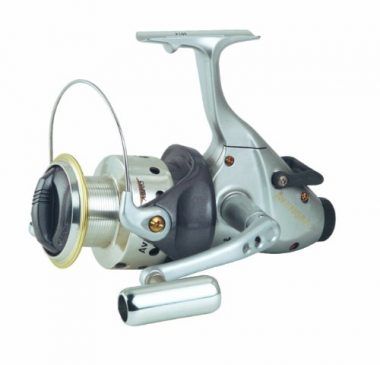
- What Makes This Spin Reel Stand Out
- On/Off Bait Feeding System
- Die-cast Aluminum Handle
- One Year Warranty
Max Drag: 8-22 pounds
Gear Ratio: 5.0:1
Weight: 8.8 – 27.6 ounces
Mono Line Capacity: 380/10 – 240/15
Ball Bearings: 6+1
Goture Metal Spool Fishing Spinning Reel
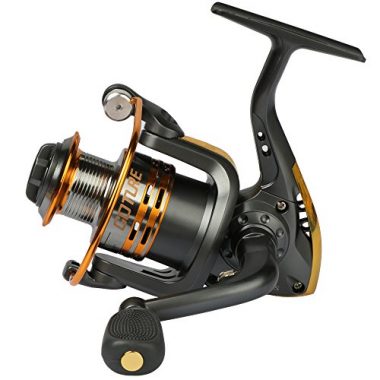
- What Makes This Spin Reel Stand Out
- 100% satisfaction guarantee
- Japanese oil felt drag washers
- Lightweight and high max drag
Max Drag: 4 – 14 pounds
Gear Ratio: 5:2:1
Weight: 9 ounces
Mono Line Capacity: 0.55/15
Ball Bearings: 6+1
Abu Garcia Revo SX Spinning Reel
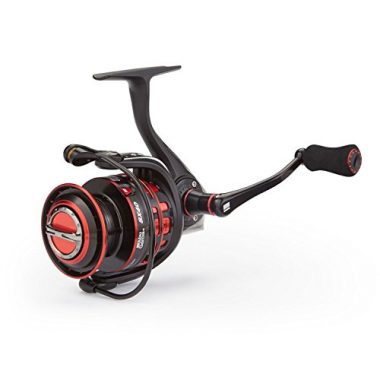
- What Makes This Spin Reel Stand Out
- Great mixture of materials
- Stylish design
- Awesome value for your money
Max Drag: 6 – 10 pounds
Gear Ratio: 6.2:1
Weight: 7.2 – 9.2 ounces
Mono Line Capacity: 110/6
Ball Bearings: 8+1
Pflueger President Spinning Reel
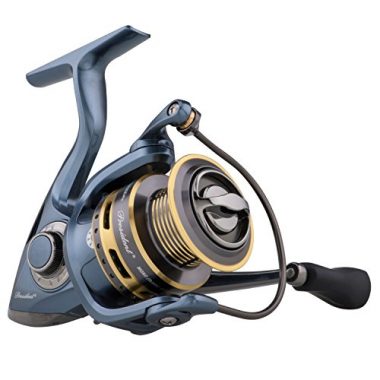
- What Makes This Spin Reel Stand Out
- 10 bearing system
- Lightweight design
- Aircraft grade aluminum handle
Max Drag: 7 – 24 pounds
Gear Ratio: 5.2:1
Weight: 5 – 9 ounces
Mono Line Capacity: 200/2, 100/4, 80/6
Ball Bearings: 9+1
Goswot 12BB Ball Bearing Fishing Spinning Reel
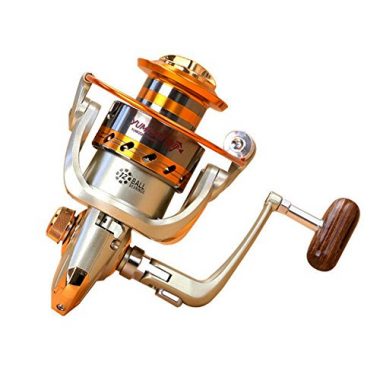
- What Makes This Spin Reel Stand Out
- Durable Wooden Handle
- 12 Ball Bearings
- Buttery Smooth Operation
Max Drag: 10 pounds
Gear Ratio: 5:1
Weight: 10 ounces
Mono Line Capacity: 100/4
Ball Bearings: 12
How To Choose A Spinning Reel – Buying Guide
Any fisherman knows the importance of having the best gear. Being well equipped will work to make you a better fisherman and allow for a much better day spent on the water. The best gear should always include having a top quality spinning reel. These are responsible for reeling in your catch and therefore play a crucial role in the sport. With so many different reels on the market, it can be tough to find the best ones for you.
While we have found and listed the best ones available on today’s market based on quality and value, it is important that you have a thorough understanding of what you are buying. This all starts with understanding the terminology and the technology that goes into the construction of your spinning reel.
To start, it is important to determine your skill level and who is going to be using the reel. For children or those very new to the sport, you will likely want to opt for a closed face spin cast reel. This type is the easiest to learn from and is the most user friendly option. That is, of course, you are looking to fish primarily for bass and are, therefore, looking for one that offers incredible precision. If this is the case, opting for a baitcast reel will be a sound option.
When you are not looking for that much specification and instead are looking for a high quality everyday reel, you will be much better suited with an open faced spinning reel. These are ideal as they don’t tangle as much and have a much lighter feel. This allows for easy use that can be cast again and again without strain to your body.
As all of your fishing will be done on the water and likely not always in the most ideal conditions, it is important to ensure your reel is properly suited for this condition. While this may be obvious, not all fishing gear is made this way. Ensuring that it is sealed, water and corrosion resistant will help to give you the most use out of your reel.
There are many other features that are important to consider when looking to purchase your next spinning reel. To help you get the most out of your money spent we have put together a complete guide below that should help you to master the terminology and in turn make you a better fisherman.
Related Review: Spinning Reel Under 50
Max Drag
Every reel will be equipped with something called a max drag system. This is something that should be present in reference to saltwater as well as freshwater fishing. The idea of the drag system refers to the pressure, or weight, put on the fish as you are reeling in. It is important to have a smooth drag as this will ensure that you can reel your fish in without jerking it. This means that you will have less of a risk of your line breaking due to shock, something that becomes increasingly important when reeling in a big catch. This can also cause your fish to pull free, also something you’ll want to avoid.
This is one of the most crucial features in your reel which means it should hold a significant importance in helping you to find your ideal unit. While not as important with a smaller catch, for those looking to reel in bigger fish, this is incredibly important. When you have a reel with a smoother drag you will be able to successfully reel in bigger fish despite a smaller line.
When identifying your reels drag system you will notice that it will most commonly be equipped with a front drag system. On this style, you will notice a dial that can be adjusted to provide your ideal amount of drag. Alternatively, there will be a rear drag system that is instead controlled with a knob. Regardless of which one you have, you will enjoy that you are able to manually control the amount of drag needed with every catch.
Most commonly, and in this article, we have measured this in terms of pounds to provide you with a uniformed comparison. You will typically find that the quality of the drag system has a direct correlation to the price you are paying. This is why opting for a cheaper reel system isn’t always the best option. It is important to focus equally on drag rating as well as drag quality. Oftentimes cheaper reel systems may still have an adequate drag pressure but will provide a rough and jerky drag that can still cause you to lose your fish. Instead, you will want to operate a system that has a smooth drag that is easier to operate.
Commonly many reel systems are equipped with 10 pounds of maximum drag pressure. Typically speaking, this is more than enough to reel in your typical catch of bass or trout. For those hoping for a bigger score, you may want to look for reels that are equipped with a maximum drag pressure closer to that of 20 pounds. Due to the intense physical necessities of reeling in anything larger than this, it is commonly unnecessary to need a reel with a drag system that exceeds this rating.
Gear Ratio
Another thing to consider when buying your next spinning reel is the gear ratio. This refers to the number of times that the bail does a full rotation around the spool during one rotation of the handle. This number plays a direct role in your retrieval speed. A number you will often see is 4:1. This means that the bail makes 4 complete rotations with every 1 rotation of the handle.
The number needed for this is directly dependent on the type of fish that you will be catching. A gear rotation of 4:1 is typically on the slower side of things. In contrast a 6:1 gear ratio is considered a fast speed and isn’t necessarily a bad thing. When looking for your next reel it is a safe bet to stick around the 5:1 ratio which will provide the best all around performance.
Ball Bearings
When looking to buy your next spinning reel it is important to note the number of ball bearings that your unit comes with. Inside your spinning reel, there will be a ball bearing, also referred to as bushings, that are placed within the body of your unit.
A good rule of thumb is the more ball bearings featured the smoother the retrieve will be. In most cases, we advise to opt for a reel that has the most amount of ball bearings while in your price range.
For beginners, we recommend looking at the 5 range for ball bearings. This is often the golden number to achieve both an affordable price and a smooth unit. Typically speaking, the quality between a 5 and 8 bearing is minimal compared to a 3 to 5 bearing. It’s not until you reach 9 or 10 that you start noticing a significant difference in reels.
Material
When looking for virtually any outdoor gear the materials used to make it will play the biggest role in its quality. When considering sporting gear, such as fishing gear, you will want a durable material that is quite hardy and can handle both a rougher use as well as all weather conditions. When specifically considering fishing gear you will want to find a material that is both strong as well as lightweight.
Historically, manufacturers have struggled to effectively tread the line between something durable and lightweight. Recently, space-age alloys have been introduced to reels which do well to keep the weight light but keep the materials strong. They do this by removing some metal and creating air pockets which help reduce the weight of the reel.
When looking at specific types of reels you will most commonly come across three main materials: graphite, aluminum and steel. You may also find some reels made of copolymer or plastic as well. However, this plastic should only be for children’s reels.
For those looking for a lightweight reel, graphite is a popular material choice. This is a decently resilient material that is most suitable for freshwater but can also be brought into areas of light saltwater. The combination of lightweight and durability create a balance that most fishermen can appreciate.
Serious fisherman will want a material that is much more durable and sturdy which is why they will turn to a metal, steel or aluminum. These are ideal for both salt and fresh water and have the hardiest construction. They can be on the heavier side but not by much. Keep in mind that metals will be much stronger than plastics. Metal will stand up to time and abuse much better as well.
You will want to be aware that not all metals are made equally. Some companies will create reels that incorporate a few different types of metal. This isn’t always a good thing. You will want to keep in mind that in most cases, the overall quality of the reel will only be as strong as the weakest material present.
Weight
As with a lot of outdoor gear you will want to give some attention to the weight of your next spinning reel. This will affect a number of different things including the feel of it, ease of portability, and even the types of fish that you are able to reel in. Fish size plays the most obvious role in your reels weight as bigger fish require bigger, heavier reels. While this is true, the weight within the different sizes also ranges quite a bit.
While the weight difference between different spinning reels may seem nominal, it can be a stark difference, specifically for those with some physical limitations or those planning to spend long days out on the lake. While a few ounce difference in weight may not be worth noting, it can wreak havoc on your joints and arms when reeling in a fish.
You may think that cost would be related to weight with your reel but this is not the case. A more expensive reel does not necessarily equal a lighter reel. The weight will instead be linked to the materials used. While aluminum may be a stronger and more reliable material, the tradeoff is that it carries a heavier weight. In contrast, graphite is a material with less quality but holds a lighter weight. For this reason, you may have to ask the question of whether you are willing to have a reel that holds a longer lifespan or one with a lighter weight.
While you may want to get the most use for your money, you also want to be sure you enjoy your day on the water instead of being tired. For those with strong physical capabilities and above average arm strength, there is no need to focus too strongly on the weight of your reel. For the rest of us, be sure to place at least a moderate focus on the weight of your reel.
Additionally, some parts simply need to be made from heavier material. Ball bearings, for example, are usually made from brass. Even though this is a heavy material, it’s also one of the strongest. Companies usually know where to put the weight when it comes to spinning reels.
Warranty
While it is possible to find spinning reels at quite an affordable price point, most times they can be quite an investment. For this reason, it is wise to get some sort of assurance that your gear will last the test of time. This is especially important in the case of reels as there many moving parts to the technology that can greatly affect the performance of the reel. Opting for a reel that is equipped with a warranty is a great choice. Many manufacturers back their products with one year manufacturers warranty that protects the mechanics of the item. This can go a long way in ensuring that you get the most from your purchase.
We recommend looking at this perk in the early stages of looking for your next spinning reel. In addition to a manufacturer’s warranty, some companies even offer risk free money back guarantees. These can be great, especially when trying a brand that you are unfamiliar with. If you are not satisfied with your purchase you can simply contact the manufacturer and send it back to them at no cost to you.
If you have found a fishing reel that does not offer a warranty don’t be too concerned. In most cases, you will be able to purchase an additional warranty that will provide you with further protection. When considering purchasing a warranty, you will want to consider how expensive your reel is. If, for example, your reel only costs $25 you may not need a warranty.
It is wise to opt for a warranty on reels that are more than about $75 in cost. As these are considered more of an investment it is wise to have them covered. If you are spending less, it may be more worthwhile to save the money to put towards your next piece of gear.
Quality Construction
Purchasing a quality spinning reel will lead to a longer lifespan, a more sturdy performance and a much better time out fishing on the water. Quality is determined by a number of things but most often is directly related to materials used in the reels construction. Most commonly, fishing spinning reels that are made from metal hold a much higher quality than those made from softer materials such as plastics.
Quality is also quite subjective being directly related to user preference. While some people will love the feel of a heavy strong reel that feels sturdy, others will find that opting for a lighter more specifically designed reel will serve their needs better and deliver a better quality experience.
While material does play a huge role, construction features is worth noting as well. Some spinning reels are designed solely for right handed users which would be a real hassle to someone who is dominant with their left. To that person, a left handed, or better an ambidextrous, design will produce far superior results and therefore deliver a more quality design. If you are left handed or are one of those people who can switch hands freely, look for a reel that can switch configurations. Some simply have a button that allows the reel to switch sides so you can switch hands mid way through your day.
Focusing on features, construction design and materials is the best way to determine what will be a high quality purchase for you. Opting for quality rather than simply price will do wonders in increasing the amount of use you get out of your reel. A high quality reel can last a lifetime so paying a bit more in the short run can save you a lot over a lifetime.
Specificity
While you can look for the absolute best spin reel on the market and opt for that, it is most wise to instead take into account the type of fishing you are intending to do. What is a great buy for one fisherman and one type of fishing may not extend to the next?
You will want to first pay attention to the type and size of fish that you are intending to catch. Bigger fish will require more advanced technology in order to reel in successfully. Likewise, the conditions, specifically saltwater versus freshwater, will also play a role in the reel that is needed.
Personalized touches such as right handed versus left handed should be paid attention to as well. Weight, as discussed throughout the article, and warranty should be accounted for. Lastly, you may be inclined to pay attention to the style and design of the specific spinning reel. While aesthetics shouldn’t be the main focus, some models will allow you to choose between different color options.
Power
A powerful fishing reel will allow you the best results for your day spent out on the water. If your reel lacks power then it will likely produce fewer results throughout your day. Most often this will mean that you will be doing a lot more work and you will reel your fish in less smooth which could even result in losing your potential catch.
Power and gear ratio are directly related. The gear ratio, as described earlier in this article, will represent how many rotations your bail makes around with every one rotation of your wrist. The more times it rotates, the more power you will get per crank. For this reason, a 4:1 gear ratio will hold much less power than a 6:1 gear ratio. In an effort to find a happy medium, we recommend opting for a gear ratio of 5:1.
FAQs
Q: What Is A Fishing Spinning Reel?
When deciding on which spinning reel to buy, it is crucial to have a thorough understanding of what exactly a spinning reel is. A fishing spinning reel is the part of the fishing rod that holds your line. This is a crucial part of your fishing rod and includes all the mechanics and technology behind it. It houses the mechanisms and gears that allow you to throw line, release it and reel it back in when you have a fish on the line. Essentially, a fishing rod would simply be a long stick without this part.
This is the part of your line that you hold and turn when reeling in your fish. The most essential part of your fishing experience, it is very important to know and understand the many moving parts of your reel. This will help you to make the best decision of spinning reel for your style and body type.
Q: Should I Have A Special Rod For This Reel Or Can I Use A Regular One?
We would love to answer this in a simple way but the truth is, it depends. Here you will have to consider a few aspects including: what, where and how you’re fishing. Typically you’ll want a different style rod for different situations. For example, if you usually fish big game in the ocean you’ll need a different rod than if you’re river fishing from your kayak.
The type of fish you’re going after will also dictate a different style rod you’ll need. An 8 lb trout will obviously require a different rod than a full sized tuna. You’ll want to do some research before you head out so you don’t end up breaking or straining your rod.
Simply speaking the rod you have should be geared towards the fish you are looking to catch or at least the size of the fish. Likewise, your reel should be geared the same way. If both your rod and your reel are designed for the same catch then they should work nicely together. You will not have issues using different manufacturers for your rod and reel as they should be compatible with each other.
Q: How Should I Clean My Spinning Reel?
You’ll want to ensure your spinning reel is cleaned after every day of fishing no matter what type of water you’re on. If you are fishing on freshwater this will be easier than if you’re on a saltwater trip. Let’s go through what you should do when fishing on saltwater.
We’re not saying you should take your reel apart every time you fish, but it’s worth it once in a while. But ensuring it’s thoroughly cleaned will make it last longer and allow it to function properly for as long as possible.
Don’t simply spray your reel off with your hose as this can actually do damage. Instead, grab a bucket and fill it with warm soapy water. Use a sponge to go over the entire reel and soaking it with the soapy water. You can rinse it with tap water, just make sure it’s not at a high pressure.
If you’re looking for a deep clean you’ll have to take the reel apart. We don’t suggest doing this unless you are confident in your abilities. If you forget a step when putting it back together your reel won’t work properly.
Related Post: How To Clean A Fishing ReelQ: Should I Have A Special Line For Spinning Reel?
Q: How Can I Choose The Best Weight For My Spinning Reel?
When determining the ideal weight for your spinning reel, it is important to start by realistically analysing your physical fitness. Those in their physical prime who have a great deal of upper body strength, specifically that in your arms, you will not need to pay as close attention to weight. This means that you can choose any reel and may even want to go with a heavier option that will sit more solidly in your hands.
It is important to be realistic when determining your physical capabilities. Many times fishing is a whole day sport where you spend a great deal of time on the water. Reeling in a fish, particularly one of a bigger size, can be quite physically demanding. While muscles play a role, it is also important to consider the strain it causes on your wrists and joints. Even if you don’t end up catching anything throwing casts all day long, for hours on end, can wreak havoc on your body. If you don’t need a heavier weighted line, don’t use it.
Physical fitness levels should be the primary deciding factor in determining how heavy your unit should be. Generally speaking, it is wise to choose the lightest option possible while doing your best to not sacrifice too much on quality construction. When choosing between a few of your top choice reels, we recommend picking the lightest option available.
Globo Surf Overview
Deciding on the best spinning reel for you should be fairly straightforward. The market is quite saturated as fishing has become quite a popular sport over the last few years. With so many options available you will have no problem finding a reel that perfectly suits your needs. It is important to first decide on the features that are most important to you and that should help to narrow down your search.
The most difficult part with finding the best reel on the market is understanding the terminology out there. With the help of this guide, you should now be able to have a comprehensive understanding of what features are important to look for.
When looking through our list of the most excellent spinning reels on the market you will realize that there are a lot of different brand names that are featured. Both big name manufacturers and smaller businesses are working hard to add the highest quality technology to help improve your fishing experience. From bottom budget options to high end ones complete with all the bells and whistles, virtually anyone can join this sport.
Due to the many different products on the market, we recommend doing a full spinning reel comparison before deciding on the ideal one for you. Reading the various user spinning reel reviews will help work to provide you with an unbiased idea of what other buyers are saying about this product. Coming in at various different price points and materials, there can be quite a difference from one spin reel to the next. For more fishing related articles please check fishing pliers, fishing backpacks, tackle boxes, fishing hats, fishing drone and fishing sunglasses.
As always, this guide is designed to help you in deciding on what is the most excellent spinning reel for you. We hope that you are now equipped with all of the information and a thorough understanding of what makes the best spinner reel to help make your day on the water even more enjoyable.
Have fun and happy fishing!
More Fishing Reviews:
- Fishing Shorts
- Trolling Rods
- Topwater Lures
- Baitcasting Rod
- Kids Fishing Poles
- Hooks For Catfish
- Fly Fishing Waders
- Crappie Bait
- Crab Traps
- Tackle Box
More Reel Reviews:
- Ultralight Spinning Reel
- Baitcasting Reel Under 100
- Surf Fishing Reel
- Ice Fishing Reel
- Musky Reel
- Trout Spinning Reel
Have you ever tried any of the spinning reels that made it on our list? Let us know how it changed your fishing experience in the comment section below.



